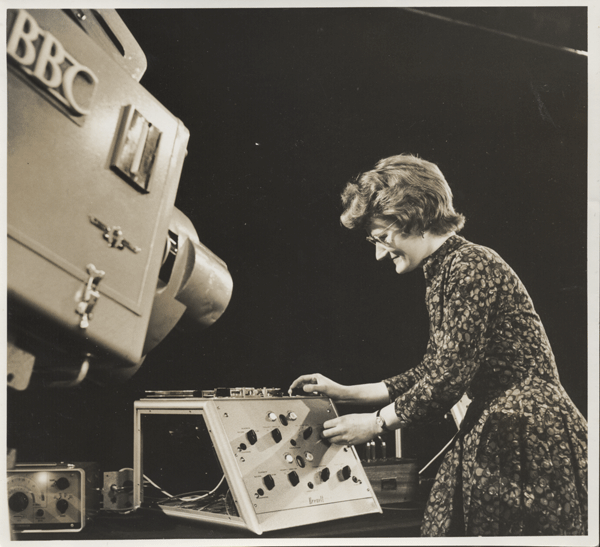Synthesizing History
Ursula Bogner is a forgotten pioneer of electronic music – at least according to the Berlin musician Jan Jelinek
Ursula Bogner is a forgotten pioneer of electronic music – at least according to the Berlin musician Jan Jelinek

I t’s still surprising to learn that some of the most decisive contributions to electronic music were made by women. The co-founder of the San Francisco Tape Music Center, Pauline Oliveros,
as well as Daphne Oram and Delia Derbyshire of the BBC Radiophonic Workshop are among the few women composers and technicians still remembered by the wider public.

For several years now, the Berlin-based musician Jan Jelinek has been trying to posthumously rehabilitate a German equivalent to these electronic music pioneers, a woman by the name of Ursula Bogner. According to Jelinek, it was a chance meeting with Bogner’s son on a flight to Vilnius that brought this pharmaceutical chemist and housewife to his attention. Bogner, who died in 1994, spent her free time attending seminars by Herbert Eimert, the founder of the Studio für elektronische Musik in Cologne; to indulge her passion for electronic music and composition, she had a music room especially built in her home. During her lifetime, her musical activities took place far from the public eye. Influenced by her reading of esoteric texts and Wilhelm Reich’s theory of orgone energy, she developed a sound concept based on Oram’s graphic sound technique ‘Oramics’, designed in 1957. In later years, Bogner was also influenced by the burgeoning of British new wave pop, which she was introduced to by her children. In the booklet for the CD Ursula Bogner: Recordings 1969–1988 (the first release on Jelinek’s own label, faitiche, founded in 2008), Jelinek describes this sound as ‘humorous and, with regard to her biography, more foolish than indebted to any kind of mysticism or science.’ Over the past two years, new followers have been given deeper insights into the conceptual roots of Bogner’s broad-based musical output through two further releases – with elaborate covers, booklets and coloured vinyl – as well as exhibitions in Hamburg and Berlin featuring linocuts, index cards and paintings from the artist’s estate.
A serious effort has been made here to give as comprehensive a picture as possible of a previously unknown oeuvre – but equally serious doubts have arisen concerning Bogner’s existence. A recent piece by Adam Harper in Wire magazine casts doubt on Bogner’s authenticity. Björn Gottstein pointed out in an early review of the first release for Spex that the eccentric-looking Bogner resembled Jelinek in drag. Even though the recordings sound perfectly genuine, this rumour spread fast. The fact that Jelinek’s live acts – performed together with fellow musician Andrew Pekler’s vintage 1960s modular synthesizers – featured improvisations based on the ‘Bogner tapes’; his claim that the incomplete state of Bogner’s original material had called for ‘re-combinations’ did little to dispel people’s suspicions. Moreover, the Institut für Medienarchäologie (Institute for Media Archaeology) in Austria – despite its commitment to ‘unearthing’ early electronic music by women – has never heard of Bogner, at least according to its website.
The box set SONNE = BLACK BOX (Sun = Black Box) released by Jelinek in late 2011 includes a CD of Voice and Tape Music by Ursula Bogner, plus a book with extensive additional material. Here, the ‘mistaken suspicion of fakery’ by the media is ironically reversed and discussed in texts and interviews. A humorous and pointed essay by Momus – reprinted from his blog and titled ‘Inside Every Synthetic Man there’s an Electronic Woman’ – focuses on female alter-egos created by male artists, from Duchamp’s Rrose Sélavy (‘Éros, c’est la vie’) onwards. From this angle, Bogner appears as a persona that enables Jelinek to expand his musical range and thus to claim his own place in the genealogy of electronic music; but she could also be a cross between Pygmalion and a female Oedipus who takes on figures like Oliveros, Derbyshire and Oram. Bogner is an oddly animated creation, but, like these female pioneers, she is pushed out of the present and into history. In the still male-dominated world of contemporary electronic music, women seem to exist only in the past, as adored, fetishized mothers, not as contemporary producers on equal footing with their male counterparts. As a result, Bogner perfectly embodies the kind of ‘faitiche’ described by the sociologist Bruno Latour – a portmanteau of fait (fact) and fétiche (fetish) to which Jelinek’s label quite obviously refers.
On the one hand, this project may be Jelinek’s way of paying his respects to the grandes dames of the synthesizer, which helps to raise their profiles – although he could also be accused of not focusing on other little known female electronic music pioneers, like the German émigré Johanna Magdalena Beyer (1888–1944). On the other hand, the project could be seen as a mischievous comment on today’s electronic music scene and its marked desire for new discoveries, especially women. By mirroring history – and perhaps himself – Jelinek may be showing the music scene its real (gendered) face.
Translated by Nicholas Grindell
















